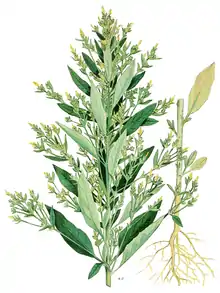Axyris amaranthoides
Axyris amaranthoides, commonly known as Russian pigweed and upright axyris,[1][2] is a species of flowering plant in the family Amaranthaceae, that has been introduced to North America. It was introduced into Manitoba in 1886 and has since spread to other provinces in Canada and the United States.[1]
| Axyris amaranthoides | |
|---|---|
 | |
| Scientific classification | |
| Kingdom: | Plantae |
| Clade: | Tracheophytes |
| Clade: | Angiosperms |
| Clade: | Eudicots |
| Order: | Caryophyllales |
| Family: | Amaranthaceae |
| Genus: | Axyris |
| Species: | A. amaranthoides |
| Binomial name | |
| Axyris amaranthoides | |
Description
Axyris amaranthoides is an annual monoecious (has both the male and female flowers in the same individual) plant. It has a taproot type of root system, and its stem is about 20–80 centimetres (8–31 in) tall and rigidly upright. The lower leaves have short petioles and have a narrowly oval to long-pointed shape. The upper leaves are narrowly lance-like to egg shaped, and attached directly to the stems or branches without petioles. The leaves on the main stems are much bigger than branch leaves, but all the leaves are serrated with slightly bent or curved backward or downward edges. A single leaf is present at each node along the stem, forming an ascending spiral pattern (alternate arrangement; see phyllotaxis).
Male flowers grow on the top of stem in the form of slim spike. One or two female flowers grow from the leaf axils below the male flowers. Fruits are oval-shaped, reddish-coloured and dry (i.e., with thin pericarps). Some fruits are winged on one side and flattened, and will germinate rapidly. Other fruits are wingless, and tend to be dormant.[3][4] The flowering time is in July and August.[1]
Habitat
Generally, A. amaranthoides grows well on very fine-grained mineral soil and soils that are made up of waste or rough fragments of stone, brick, and concrete.[1] It can be found in dry roadsides and waste places, or in open flat habitats like grassland.[5]
Range
| Country | Regions |
|---|---|
| China | Gansu, Hebei, Heilongjiang, Jilin, Liaoning, Nei Monggol, Qinghai, Shaanxi, Xinjiang |
| Siberia | Russian Federation - Eastern Siberia, Western Siberia |
| Mongolia | Mongolia |
| Russian Far East | Russian Federation - Far East |
| Eastern Asia | Japan; Korea |
| Middle Asia | Kazakhstan |
| East Europe | Southeast Europe |
Axyris amaranthoides is naturalized in North America, but is originally from Russia or Siberia (Scoggan, 1978). It is distributed throughout Canada and the northern United States. It spread in several provinces in Canada, including British Columbia, New Brunswick, Prince Edward Island, Nova Scotia, Québec, Saskatchewan and Ontario. A. amaranthoides can also be found in some regions of Asia and Europe outside its native range.[6]
Importance to humans
Axyris amaranthoides is widely used in traditional Chinese medicine. It has several functions, such as clearing the liver and improving vision, relieving rheumatic pains, treating decayed teeth, relieving swelling and preventing high blood pressure.[7] Like that of many wind-pollinated plants, the pollen of A. amaranthoides can cause allergic respiratory diseases.[8]
Importance to ecosystems
Axyris amaranthoides spreads aggressively to many regions, and displaces native species in the process; it is considered an invasive species that had negative influences in North Dakota.[1] In addition, A. amaranthoides may cause seed contamination in cereal crops.[1]
Conservation
The conservation status of A. amaranthoides is not listed in Canada or the United States, probably because it is an invasive species and the two countries have programs in place to control its spread.[9][6]
References
- W. H. Blackwell (1978). "History of Russian pigweed, Axyris-amaranthoides (Chenopodiaceae, Atripliceae), in North-America". Weed Science. 26 (1): 82–84. doi:10.1017/S0043174500032720. JSTOR 4042694. S2CID 190908386.
- BSBI List 2007 (xls). Botanical Society of Britain and Ireland. Archived from the original (xls) on 2015-06-26. Retrieved 2014-10-17.
- N. Britton & H. Brown (1970). An illustrated flora of the Northern United States and Canada. Vol. 2. New York: Dover Publications.
- "Axyris amaranthoides". Interactive Agricultural Ecological Atlas of Russia and Neighboring Countries. Retrieved October 20, 2011.
- H. Scoggan (1978). The Flora of Canada. Vol. 3. National Museums of Canada.
- "Axyris amaranthoides". Germplasm Resources Information Network. Agricultural Research Service, United States Department of Agriculture. Retrieved October 20, 2011.
- Subject Database of China Plant. Retrieved October 20, 2011, from "Axyris amaranthoides | 中国植物主题数据库". Archived from the original on 2012-04-26. Retrieved 2011-12-04.
- Richard W. Weber & Harold S. Nelson (1985). "Pollen allergens and their interrelationships". Clinical Reviews in Allergy & Immunology. 3 (3): 291–318. doi:10.1007/BF02992997. PMID 3893674. S2CID 45938872.
- Axyris amaranthoides. Committee on the Status of Endangered Wildlife in Canada. Retrieved October 20, 2011, from "Cosewic". Archived from the original on 2007-10-25. Retrieved 2007-07-15.